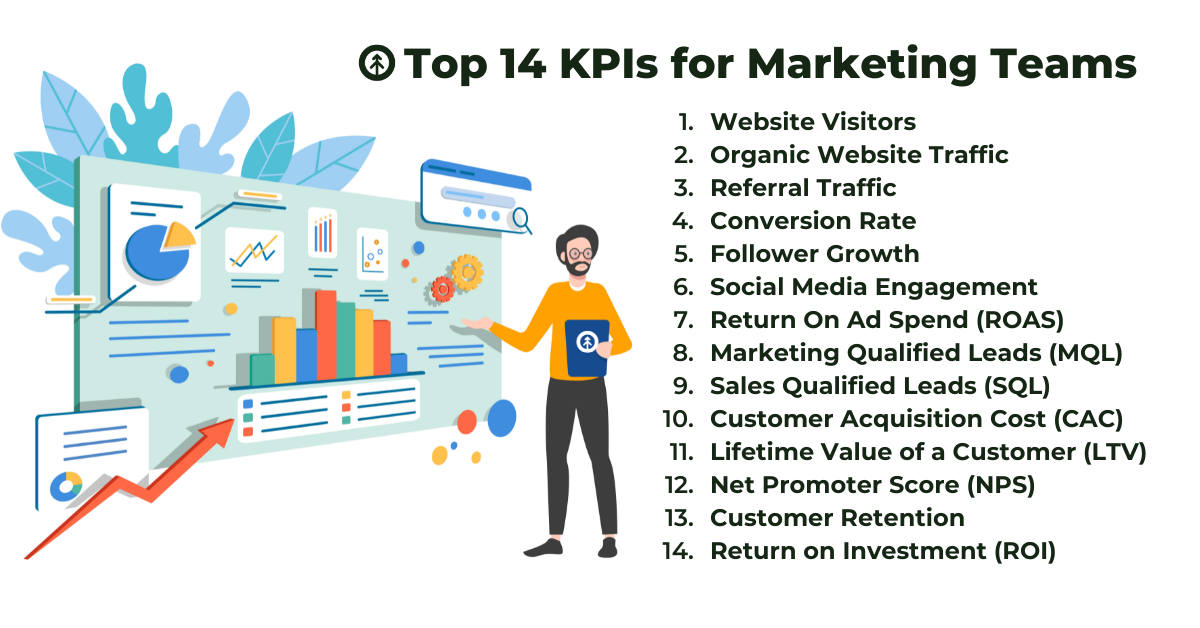The best key performance indicators (or KPIs) derive from aligning data with your business goals. Analysis of KPIs can help you measure how well your organization is performing with respect to those goals.
When everything your organization does in sales, marketing, and service is tracked in HubSpot, you have access to reports that include some of the best KPIs already built in (as well, HubSpot makes building custom reports super easy).
Fun fact: each member of your team can build their own KPI dashboard in HubSpot to keep track as they go.
So, with that in mind, we've put together a list of the top 14 KPIs for tracking the success of all your marketing strategies and efforts.

- Website Visitors
- Organic Website Traffic
- Referral Traffic
- Conversion Rate
- Follower Growth
- Social Media Engagement
- Return On Ad Spend (ROAS)
- Marketing Qualified Leads (MQL)
- Sales Qualified Leads (SQL)
- Customer Acquisition Cost (CAC)
- Lifetime Value of a Customer (LTV)
- Net Promoter Score (NPS)
- Customer Retention
- Return on Investment (ROI)
Let's get into some details on these valuable KPIs for your marketing team.
1. Website Visitors
Your marketing team is responsible for everything on your website, so tracking the number of visitors your website attracts is a good way to measure its success and adjust accordingly.
Pay careful attention to where the visitor came from (i.e. your social media channels, organic traffic, etc.) so you can iterate as you go (which is the true beauty of having data on your side).
2. Organic Website Traffic
When people land on your website after performing a Google search for what your business does, you've arrived.
This means that your marketing team has done a great job with SEO, yes. But it also proves that they've created content that's relevant and helpful to your ideal customer. That's the benefit of a strong inbound marketing strategy.
3. Referral Traffic

This KPI shows you how your website visitors found your business. When you understand where most of your visitors are coming from (social media, Google searches, etc.), you can align your marketing strategy around making that happen more.
4. Conversion Rate
This metric refers specifically to the percentage of visitors who performed a desired action on your website. That action could be anything from filling out a form to buying something to signing up for a demo.
It shows how well your website (and everything on it) is at gathering leads.
5. Follower Growth
If part of your marketing strategy involves increasing your brand awareness through social media channels (which it really must in order to be successful), tracking follower growth is key to understanding how well your marketing team's interactions with your audience on your brand channels are working.
If you're gaining followers, you're generating brand evangelists, and that drives the flywheel that grows your business.
6. Social Media Engagement

Social media is a key marketing strategy, so tracking engagement on your official brand channels allows your marketing team to understand how many likes, shares, comments, messages, tags, or mentions by leads or customers are actually occurring in that space.
The engagement KPI lets them analyze over time (and in real-time if you have HubSpot) how well their hard work is paying off for the business.
7. Return on Ad Spend (ROAS)
ROAS focuses on the ROI of your advertising campaigns. It's calculated by dividing your revenue by the amount you've spent on advertising.
The KPI itself is usually represented by a ratio. For instance, if for every $20 you've earned in revenue you spent $2, you have a 10:1 ROAS. Nice.
8. Marketing Qualified Leads (MQL)
If a prospect has engaged with your brand in some way, and they're on the buyer's journey (and could become an ideal lead or customer with some nurturing), they are an MQL.
Marketing teams should keep their eyes on this KPI to understand the number of leads they're bringing to the sales team (which, at the end of the day, is the job they do best for your business).
9. Sales Qualified Leads (SQL)
.png?width=1200&name=kpis-marketing-teams-laptop-data%20(1).png)
When MQLs are well-nurtured, they grow up to become SQLs (or prospective leads) who are ready to have conversations with your sales team.
This takes research and vetting by your marketing team. This KPI shows them when they're doing their best work as a team.
10. Customer Acquisition Cost (CAC)
CAC is the amount you're spending to convert a prospect into a customer. It takes into consideration complex data points around your business revenue, sales, and marketing costs.
Luckily, HubSpot does all the math for you so you don't spend too much on marketing when what you're doing specifically isn't generating revenue. This way, you can shift your approach, focus, and marketing budget accordingly.
11. Lifetime Value of a Customer (LTV)
LTV indicates the total amount of revenue a business can expect to make from a single customer. It also helps you make data-driven decisions about how much money to spend on marketing going forward.
Compare this metric to the Customer Acquisition Cost (CAC). If your LTV is higher than your CAC, you're moving in the right direction for sustained growth. Keep it up! If it's the other way around, too much is being spent to get new customers.
12. Net Promoter Score (NPS)
NPS is calculated based on customer feedback. It shows you a percentage of your customers who would recommend your business to a friend or family member.
As well, when you gather the data through surveys that allow space for comments, you gain insights into how to improve your customer's experience on their buyer journey and beyond.
This is key feedback for your marketing team as much as it is for your sales and service teams.
13. Customer Retention
How well you hang on to your existing customers is an important KPI for marketing because when you're retaining customers, you're attracting the right ones in the first place (which is the job of the marketing team).
As well, it shows a strong alignment with sales and service teams. If customer retention is low, it's an opportunity for your teams to get together and discuss a more unified plan.
14. Return on Investment (ROI)

The ROI of your marketing efforts is calculated by subtracting marketing expenses from sales and dividing that number by marketing cost:
Sales Growth - Marketing Cost / Marketing Cost = Marketing ROI
However, it can be hard to know how many sales can be attributed to marketing efforts. In that case, subtract organic sales from overall sales before using the above formula.
So:
Sales Growth - Organic Sales Growth - Marketing Cost) / Marketing Cost = Marketing ROI
When your marketing team knows their goals and can track them easily throughout the month, those goals are that much easier to reach.
Growth is big into using the data we gather through HubSpot for accountability, transparency, and iteration.
Each member of our team has their own reporting dashboard that they build themselves to help them show how well they're doing, and we share these in our team meetings with great applause and support.
It's a large part of our company culture, and it drives our growth mindset and our success as a business and as humans who love what we do.
Want to have that much fun and grow your business in the process? Ask us how we do it. We're right here.
